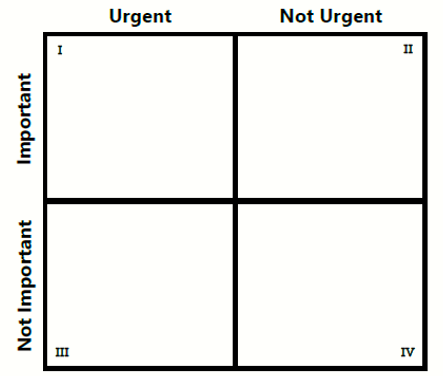The ability to manage our time and tasks effectively has become a valuable skill. The “Urgent-Important Matrix” is a simple but powerful tool, which can transform how you approach your to-do list and maximise your productivity by placing each task in the appropriate quadrant. In this blog post, we’ll explore the concept of the Urgent-Important Matrix and how it can help you make informed decisions, prioritise tasks, and achieve your goals.
Understanding the Urgent-Important Matrix
The Urgent-Important Matrix, sometimes known as the Eisenhower Matrix, is a time management and Prioritisation tool. The matrix categorises tasks based on two key factors: urgency and importance. By sorting tasks into four distinct quadrants, you can gain clarity on where to focus your efforts and ensure that you’re spending your time on activities that truly matter.
Quadrant I: Urgent and Important
Tasks falling into this quadrant are both urgent and important. They require immediate attention and can significantly impact your goals, well-being, or deadlines. These tasks often arise unexpectedly and demand immediate action. Examples include pressing deadlines, crises, and time-sensitive projects. While it’s important to address these tasks, constant firefighting can lead to stress and burnout if not managed effectively.
Quadrant II: Not Urgent but Important
This quadrant encompasses tasks that are important but not necessarily time sensitive. Focusing on Quadrant II tasks is key to both proactive and strategic planning. This is where you’ll find activities like goal setting, long-term planning, skill development, and building relationships. Investing time in Quadrant II can prevent tasks from moving into Quadrant I and enhance your overall productivity and well-being.
Quadrant III: Urgent but Not Important
Quadrant III contains tasks that are urgent but lack true importance. These tasks often involve distractions, interruptions, or other people’s priorities that may not align with your own. While these tasks may seem pressing, they can divert your attention from more meaningful activities. Delegating or minimising Quadrant III tasks can free up time for higher-priority activities.
Quadrant IV: Not Urgent and Not Important
Tasks here have neither urgency nor importance. They are timewasters that offer little to no value in achieving your goals. Engaging in Quadrant IV activities, such as mindless scrolling on social media or other unhelpful distractions, can hinder your productivity and prevent you from focusing on more valuable activities.
How to use the Matrix
Using the Urgent-Important Matrix requires a thoughtful and systematic approach:
- Identify Tasks: Start by listing all the tasks on your to-do list.
- Categorise Tasks: Place each task in the appropriate place based on its level of urgency and importance.
- Prioritise: Focus on tasks in the top left, but also allocate time for Quadrant II activities to prevent future crises.
- Delegate or Limit: Find ways to delegate Quadrant III tasks or limit your involvement to maintain your focus.
- Eliminate or Minimise: Avoid activities in the bottom right, as they offer little value to your goals.
Summary
The Urgent-Important Matrix is a great tool for anyone wanting to improve their time management, make informed decisions, and enhance productivity. By categorising tasks based on their urgency and importance, you can prioritise effectively, reduce stress, and maintain a healthy work-life balance. By aligning your daily actions with your long-term goals, you can take control of your time and pave the way for greater success.










